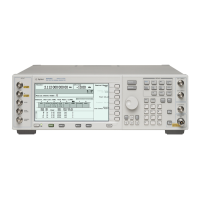Chapter 17 605
W-CDMA Downlink Digital Modulation for Receiver Test
Configuring for Out-of-Synchronization Testing
When the trigger polarity selection is positive, the DPCH DTX occurs while the gating signal is high.
The reverse is true when the trigger polarity selection is negative. When the trigger polarity selection is
negative, the DPCH DTX starts when the out-of-synchronization mode is turned on since the absence of
a trigger is interpreted as if the gating signal was low.
2. Press the
Mode Setup hardkey to return to the first-level W-CDMA softkey menu.
Generating the Baseband Signal and Activating the Out-Of-Synchronization Test Feature
1. Press the W-CDMA Off On softkey to On.
This step can be performed at anytime during the setup. The advantage of turning the format on before
setting up the signal, if you have a spectrum analyzer or some other measuring equipment connected, is
you can see the changes as they are made. However you may experience a slight delay in signal
processing while the ESG updates the W-CDMA signal with any changes that are made.
2. Press
More (1 of 2) > Out-of-sync Test Off On to On.
This prepares the ESG to receive the DPCH DTX trigger gating signal.
Configuring the UE
Using the UE controller, configure the mobile for the call setup procedure to receive the ESG signal
ensuring that the receiver frequency is set to the same as the ESG.
Setting Up the Spectrum Analyzer for Detecting the UE DTX
For this procedure we are using the Agilent E4440A PSA Spectrum Analyzer.
1. Preset the spectrum analyzer.
2. Configure the spectrum analyzer to accept an external 10 MHz frequency reference.
a. Press
System > Reference > Freq Ref nn.nnnnn MHz Int Ext until Ext is underscored.
b. Press
10 > MHz.
3. Select the spectrum analysis mode.
Press
Mode > Spectrum Analysis.
4. Set the frequency to match the transmission frequency of the UE.
a. Press the
Frequency hardkey.
b. Using the numeric keypad, enter the frequency of the UE signal.
5. Set a zero frequency span.
Press
Span > Zero Span.

